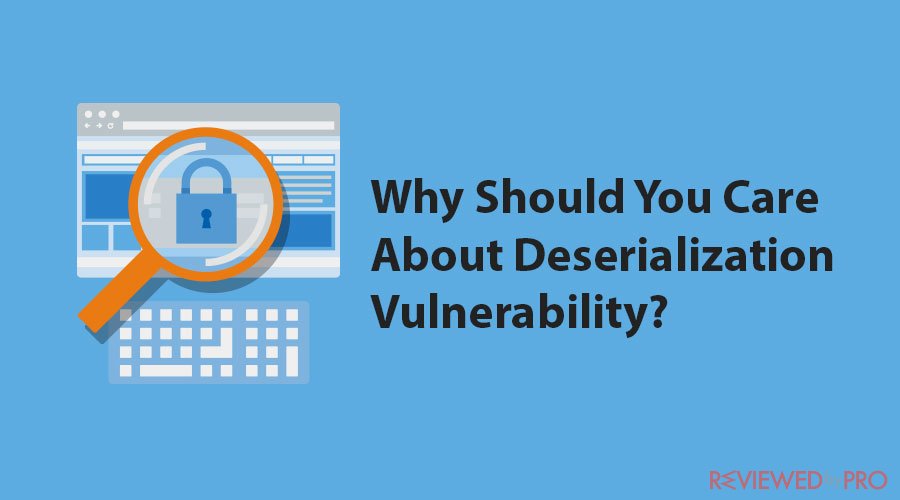
Deserialization vulnerability, also known as unsecured deserialization, is a common and potentially disastrous security flaw. The problem with deserialization is that it can be exploited by attackers who send maliciously crafted data to the program. The program, when attempting to deserialize the data, may execute arbitrary code included in the payload. This can lead to serious consequences such as data loss, unauthorized access, or even a complete system takeover. One reason deserialization vulnerabilities are so dangerous is that they can often bypass traditional security measures such as input validation and authentication. In addition, these vulnerabilities are not always easy to detect or fix, making them a favorite target of attackers. To prevent deserialization vulnerabilities, it is important to ensure that only trusted data is deserialized and that the process is performed in a secure environment with proper access controls. Additionally, implementing strict input validation and using secure serialization libraries can help mitigate the risk of these vulnerabilities.
Deserialization Security Issues
When a website deserializes the data it has received, it is engaging in an unsecured deserialization process. Once deserialization begins, the application is already compromised since the attacker has tampered with the serialized object and inserted malicious code.
This “belief” that user input is safe is the single largest pitfall of computer languages. One of the most fundamental principles of secure programming is to always treat the user as though they are attempting to get into your app. By choosing this route, you may avoid the pitfalls that might arise from delayed application protection and instead build out with more care from the get-go.
Deserialization attacks have become increasingly common in recent years, and they are a major concern for website security. Attackers can exploit these vulnerabilities to take control of the application or steal sensitive information. Therefore, it's crucial for developers to implement secure deserialization practices to prevent such attacks. An attacker might cause remote code execution, a denial of service, or other issues by leveraging your deserialization flaw.
One of the ways to ensure secure deserialization is to use whitelisting techniques, which restrict the types of objects that can be deserialized. This approach helps prevent malicious code injection by only allowing trusted classes to be deserialized. Another method is to use encryption and signature verification to ensure the integrity and authenticity of the serialized data.
It's also essential to keep all software components up-to-date and apply security patches promptly. Additionally, developers should consider implementing input validation and output encoding to prevent other common web vulnerabilities like SQL injection and cross-site scripting attacks.
In conclusion, deserialization security issues pose a significant threat to websites, and developers must take proactive measures to prevent such attacks. By adopting secure coding practices and regularly testing their applications, companies can ensure that their users' data is protected from malicious actors. A testing company can help you with this https://www.dataart.com/services/security/penetration-testing-services
Protecting Your Applications
Simplest of all, never deserialize user input is the best technique to prevent deserialization. However, most developers mistakenly believe they are secure as long as they validate deserialized data. Because there are so many unknowns and moving parts, it's difficult, if not impossible, to implement a validation process that can be considered completely foolproof.
Many programmers mistakenly believe that deserialization is safe when using a language that employs a binary serialization format; nevertheless, hackers are increasingly likely to avoid such scenarios by using techniques similar to those used with string-based formats.
Dependencies are a serious vulnerability for many contemporary programs. Developers aren't hesitant about using them in their code, and although they certainly simplify our life, they also introduce some danger. Since these dependencies add a lot of code, and it's probably not possible to monitor it all in detail, this leaves room for hackers to take advantage of, and one approach they may use is deserialization.
Conclusion
A long-term strategy for safe coding involves securing and managing your applications. You may prevent potential security issues, such as the deserialization vulnerability, by following these steps. It is vital to have someone on your team who can detect and prevent these dangers. Although we realize there may be times when this is not possible. At this point, you can count on Bright Security. We have a scanner that can help you rapidly identify security flaws and provide guidance on how to fix them.
The greatest part is that false positives are few; you won't have to make changes to your application because of unfounded warnings. Get going right away, and you'll be glad you did later on when you've built an impenetrable and trustworthy app.




